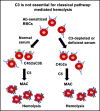Absence of complement component 3 does not prevent classical pathway-mediated hemolysis
- PMID: 31196848
- PMCID: PMC6595256
- DOI: 10.1182/bloodadvances.2019031591
Absence of complement component 3 does not prevent classical pathway-mediated hemolysis
Abstract
Complement component 3 (C3) is emerging as a potential therapeutic target. We studied complement-mediated hemolysis using normal and C3-depleted human sera, wild-type (WT) and C3-deficient rat sera, and WT and C3 knockout rat models. In all of the in vitro and in vivo experiments, we found that the loss of C3 did not prevent classical pathway-mediated hemolysis, but it did almost abolish alternative pathway-mediated hemolysis. Experiments using preassembled classical pathway C3 convertases confirmed that C4b2a directly activated complement component 5 (C5), leading to membrane attack complex formation and hemolysis. Our results suggest that targeting C3 should effectively inhibit hemolysis and tissue damage mediated by the alternative pathway of complement activation, but this approach might have limited efficacy in treating classical pathway-mediated pathological conditions.
© 2019 by The American Society of Hematology.
Conflict of interest statement
Conflict-of-interest disclosure: The authors declare no competing financial interests.
Figures





Similar articles
-
Trypanosoma lewisi: restriction of alternative complement pathway C3/C5 convertase activity.Exp Parasitol. 1987 Jun;63(3):260-71. doi: 10.1016/0014-4894(87)90172-x. Exp Parasitol. 1987. PMID: 3556206
-
Active sites in complement components C5 and C3 identified by proximity to indels in the C3/4/5 protein family.J Immunol. 1999 Jun 1;162(11):6580-8. J Immunol. 1999. PMID: 10352274
-
Structure/function of C5 convertases of complement.Int Immunopharmacol. 2001 Mar;1(3):415-22. doi: 10.1016/s1567-5769(00)00039-4. Int Immunopharmacol. 2001. PMID: 11367526 Review.
-
Protection of the classical and alternative complement pathway C3 convertases, stabilized by nephritic factors, from decay by the human C3b receptor.Eur J Immunol. 1984 Dec;14(12):1111-4. doi: 10.1002/eji.1830141209. Eur J Immunol. 1984. PMID: 6240408
-
[Proteases in complement system (author's transl)].Tanpakushitsu Kakusan Koso. 1980;25(6):531-46. Tanpakushitsu Kakusan Koso. 1980. PMID: 7010425 Review. Japanese. No abstract available.
Cited by
-
CG001, a C3b-targeted complement inhibitor, blocks 3 complement pathways: development and preclinical evaluation.Blood Adv. 2024 Aug 13;8(15):4181-4193. doi: 10.1182/bloodadvances.2024012874. Blood Adv. 2024. PMID: 38865712 Free PMC article.
-
Triple-fusion protein (TriFu): A potent, targeted, enzyme-like inhibitor of all three complement activation pathways.J Biol Chem. 2024 Apr;300(4):105784. doi: 10.1016/j.jbc.2024.105784. Epub 2024 Feb 23. J Biol Chem. 2024. PMID: 38401844 Free PMC article.
-
Complement biosensors identify a classical pathway stimulus in complement-mediated thrombotic microangiopathy.Blood. 2024 Dec 12;144(24):2528-2545. doi: 10.1182/blood.2024025850. Blood. 2024. PMID: 39357054
-
Protein therapeutics and their lessons: Expect the unexpected when inhibiting the multi-protein cascade of the complement system.Immunol Rev. 2023 Jan;313(1):376-401. doi: 10.1111/imr.13164. Epub 2022 Nov 18. Immunol Rev. 2023. PMID: 36398537 Free PMC article. Review.
-
Inflammatory Progression in Patients Undergoing Extracorporeal Membrane Oxygenation.Curr Mol Med. 2024;24(7):844-855. doi: 10.2174/1566524023666230619102723. Curr Mol Med. 2024. PMID: 37340745 Review.
References
-
- Molina H, Miwa T, Zhou L, et al. . Complement-mediated clearance of erythrocytes: mechanism and delineation of the regulatory roles of Crry and DAF. Decay-accelerating factor. Blood. 2002;100(13):4544-4549. - PubMed
Publication types
MeSH terms
Substances
Grants and funding
LinkOut - more resources
Full Text Sources
Other Literature Sources
Miscellaneous

